We’ve all been in that situation where you get a text message or a comment on your social media post, and where you weren’t not sure if the person commenting was joking or not. Especially when there isn’t any interpunction included. So you can imagine how difficult it is sometimes for a business to discern whether the feedback their customers give is genuinely positive or negative. This is where sentiment analysis tools step in.
💡 Read Sentiment Analysis 101: Everything You Need to Know
Keeping tabs on consumer sentiment is essential to the success of any business. After all, doing so helps you understand what motivates your customers, what puts them off, and what exactly influences their purchasing behavior. Hence, this explains the need to use the correct sentiment analysis tools to help you in your marketing strategies.
In this blog we’ll go through some of the best sentiment analysis tools available right now and some of their most prominent features.
What is Sentiment Analysis?
Sentiment analysis is the process that helps you understand what consumers think and say and also if there is anything between the lines. Simply put, it gives you the thoughts and hearts of the consumers by getting the tone behind anything. This refers to brand mentions, reviews, feedback, social media posts, and more, whether negative, positive, or neutral.
Armed with such intel, you will know what works for your marketing campaigns and what does not. Moreover, a change in the sentiment can serve as an effective signal of a successful or failed marketing campaign or product launch.
Then, you can make the necessary adjustments in your marketing effort to help increase your brand awareness and improve customer satisfaction. A successful marketing campaign relies on listening to your customers and helping resolve their issues.

What are Sentiment Analysis Tools?
Technological advancement has made things easier for everybody. For example, Google Voice is a web-based communication tool that facilitates sending and receiving text messages, voicemails, and phone calls, making distance shorter for everyone. The same applies to tools that help with analyzing market sentiment.
Sentiment analysis tools utilize machine learning, Natural Language Processing (NLP), and text analysis to identify and extract relevant information. They then quantify any unstructured data and make sense of such information. After that they convert everything into a score that helps marketers know what drives the positive or negative reaction.
This valuable customer insight enables you to spot trends over time and identify customers’ changing purchasing behavior and pain points.
Read How to Conduct Sentiment Analysis to Improve Customer Experience?
Best Sentiment Analysis Tools
Although sentiment analysis tools help you understand your consumers better, you must take the whole context into consideration. Sentiment analysis tools are purely tools operating on a code.
There are certain situations when they may not be able to tell the difference. For example, between a nasty comment and a joke. Despite that, sentiment analysis tools are still the best way to get to know your customers better.
Here are five best sentiment analysis tools that you can consider:
1. Lexalytics
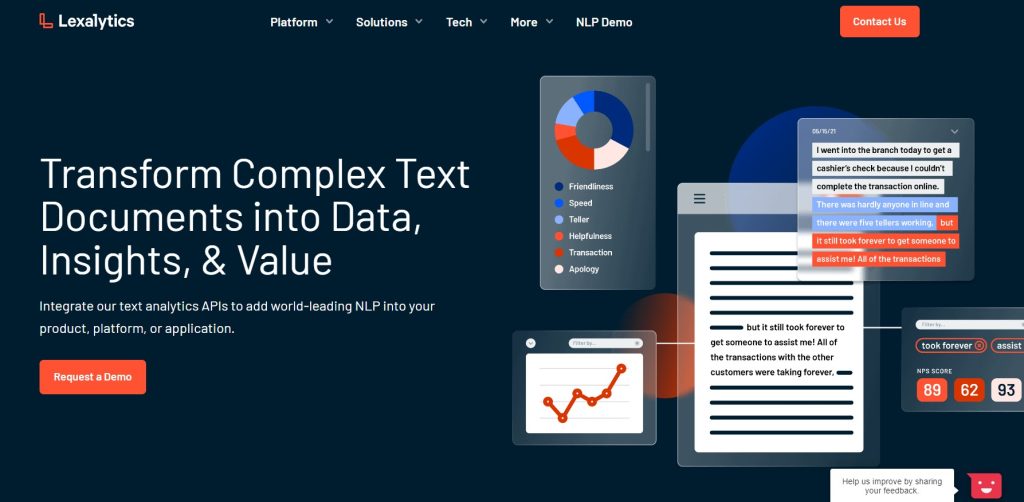
Founded in 2004 by Jeff Catlin and Mike Marshall, Lexalytics claims to handle billions of unstructured documents daily across the globe. Big guns like Microsoft use them. Their tools are based on the cloud and on-premise NLP and machine learning technologies. Finally, their ultimate goal is to transform data into profitable and actionable insights.
What makes Lexalytics likeable?
Lexalytics have an on-premise solution with Salience or in the cloud/ hybrid cloud infrastructure with their SaaS Semantria solution.
You can integrate Salience into your existing infrastructure or even white-label it in your data analytics product. Salience is fast, processing 200 tweets/second with high scalability and customization capabilities.
However, you can explore their Semantria API (Representational State Transfer (RESTful) API) with graphical configuration and management tools. The versatility is varied as you can use it on-premise, in public/ private clouds, and even within a hybrid cloud infrastructure. Also, its capability to scale up or down and customize makes it highly adaptable.
It works on data of all forms, including people voices, market research, news monitoring, social listening, and others. Lexalytics extracts and interprets response text to reveal context-rich patterns and invaluable insights.
For example, its sentiment analyzer listens to relevant social media platforms and dissects and measures the feedback, conversations, and crises to perform text analysis of your social media.
2. Reputaste
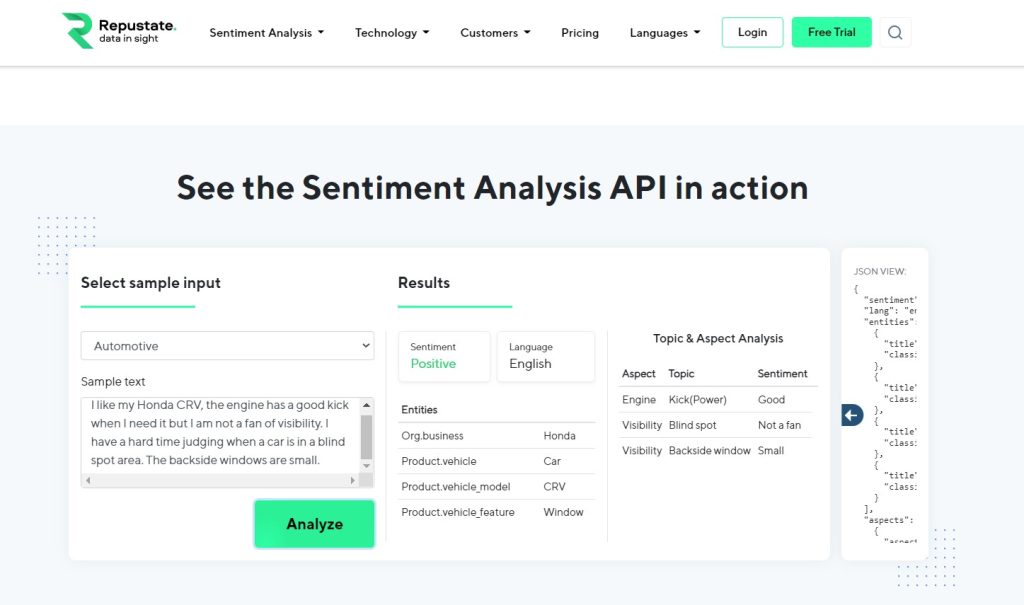
Based in Toronto, Canada, Reputaste was founded in 2010 by Martin Ostrovsky, who believed in simplifying complex problems with machine automation. Hence, the birth of Repustate, aka State of your Reputation. Their customers are varied, ranging from healthcare, banking, education, automotive, and governance, to others.
What makes Reputaste likeable?
Reputaste shines in its AI-powered semantic technology solutions that can model sentiment analysis, text analytics, and enterprise search solutions that suit businesses of all shapes and sizes. Also, Reputaste accurately analyses data across numerous sources, supported by six million entities and 300 classifications.
Additionally, it can read and analyze data natively in more than 23 languages. There’s no need for translations. Hence, it is faster and more accurate. You will find it easy to deploy the solution through a one-click installer.
Combining NLP, AI, and machine learning, Reputaste converts text and video into meaningful business intelligence for companies. This explains the strength that Reputaste has in reading the sentiments on TikTok.
TikTok is highly popular. It makes sense to keep tabs on consumer sentiment on this platform. If your target audience is on TikTok, you want to be in-trend, stay current, and relevant. Therefore, it is in your best interest to discover the whys behind the videos on TikTok so you can take corrective measures for your business. They provide customizable machine-learned NLP models to suit each customer’s needs. What is more, their solutions can be deployed on-premise or in the cloud.
Also, Repustate allows integration with other third-party products such as TikTok & Douyin, YouTube, Twitch, Twitter, Instagram, and others. This helps streamline your social media listening effort. Also, there are many graphical data presentation options you can choose from.
3. Determ
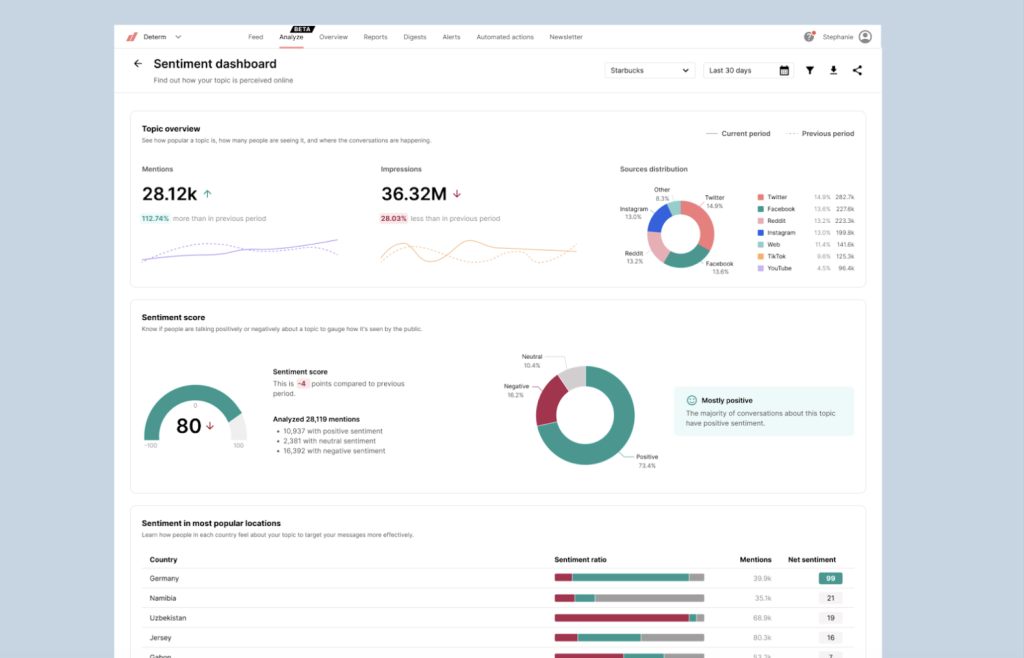
Launched in 2014 by Degordian, an independent digital production and marketing agency, Determ diversified as a separate entity in 2016. As of current writing, they have garnered more than 45,000 users from 105 countries across the globe, and they are mainly targeted at PR and marketing agency owners and specialists.
What makes Determ likeable?
Determ performs real-time tracking across more than 100 million online sources; this is an excellent global coverage figure! It tracks mentions in any language on websites, forums, social media, blogs, comments, and more. In that way, you get to be in control of what is happening online and can stay ahead of the trends.
Determ monitors mentions in real-time and calculates the sentiment – positive, neutral, or negative. In this context, you can set up real-time alerts and notifications whenever your keyword is mentioned somewhere online. In this way you can handle the more urgent mentions to mitigate the negative impact on your business.
Another great feature is an option of doing competitive analysis through the tool’s PR reports. This will enable you to see the sentiment around your competitors’ campaigns and brands in general and will help you learn what to avoid in your future campaigns.
It’s possible to track 90 days of historical data, and if you need more, they’re available upon request. Also, its search and filtering options (by location, sentiment, language, and author) are plentiful, explaining the greater flexibility. There are over 2000 predefined data points that you can base your reports on to provide clearer visibility on the insights into your business.
The interface sports a minimalist look, which is easy to understand and use. Also, there are media monitoring APIs that you can utilize to achieve the customization you need by integrating them into your website or the tools of your choice. They are available in streaming API and REST API. You can combine them to enjoy a more wholesome and full-scope media intelligence solution.
4. MonkeyLearn
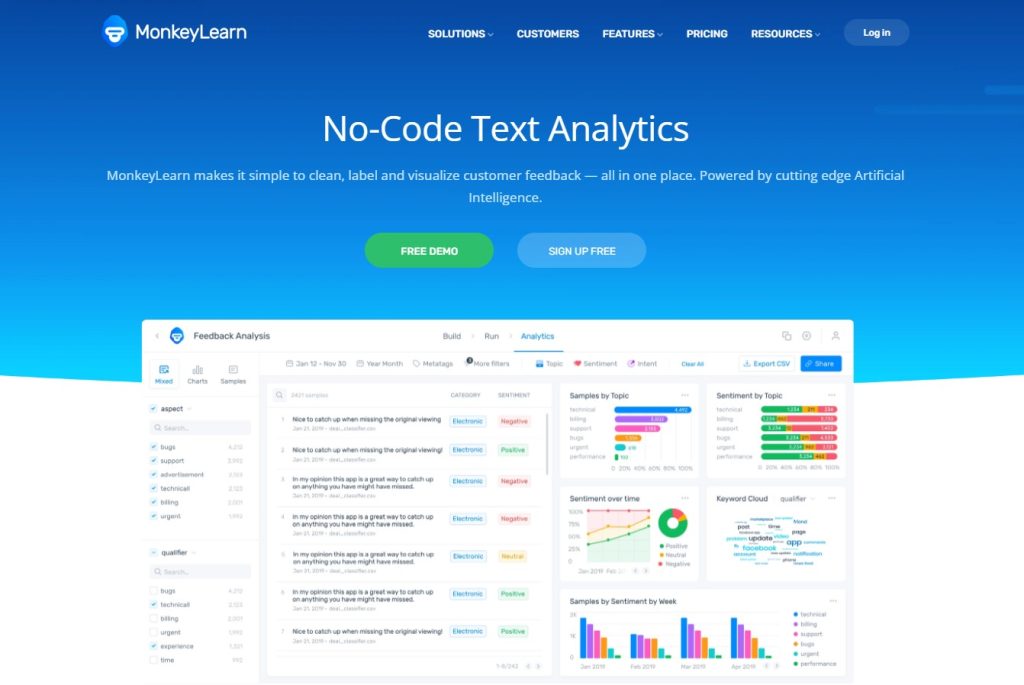
Based in San Francisco, California, USA, MonkeyLearn is an online platform that makes it easy for the average Joe with no coding skills who need sentiment analysis with high accuracy. Dell uses MonkeyLearn and claims to have saved many employee hours on their Survey Analysis tool.
What makes MonkeyLearn likeable?
MonkeyLearn collects a high volume of customer feedback and segregates them by categories. You get to track customer sentiment by topic over time. You can then identify and correct anything necessary to improve customer satisfaction. MonkeyLearn is real-time and speedy.
You can also work on a batch of data via their pre-trained sentiment analysis model by uploading a batch file from a CSV or an Excel file. MonkeyLearn allows integrations with Google Sheets, Zapier, Rapidminer, or Zendesk, making work more seamless. Or if you’re tech-savvy, you can use the MonkeyLearn API to work within your software.
If adventurous, you can create a custom sentiment analysis model to classify expressions specific to your industry and follow certain criteria.
5. Critical Mention
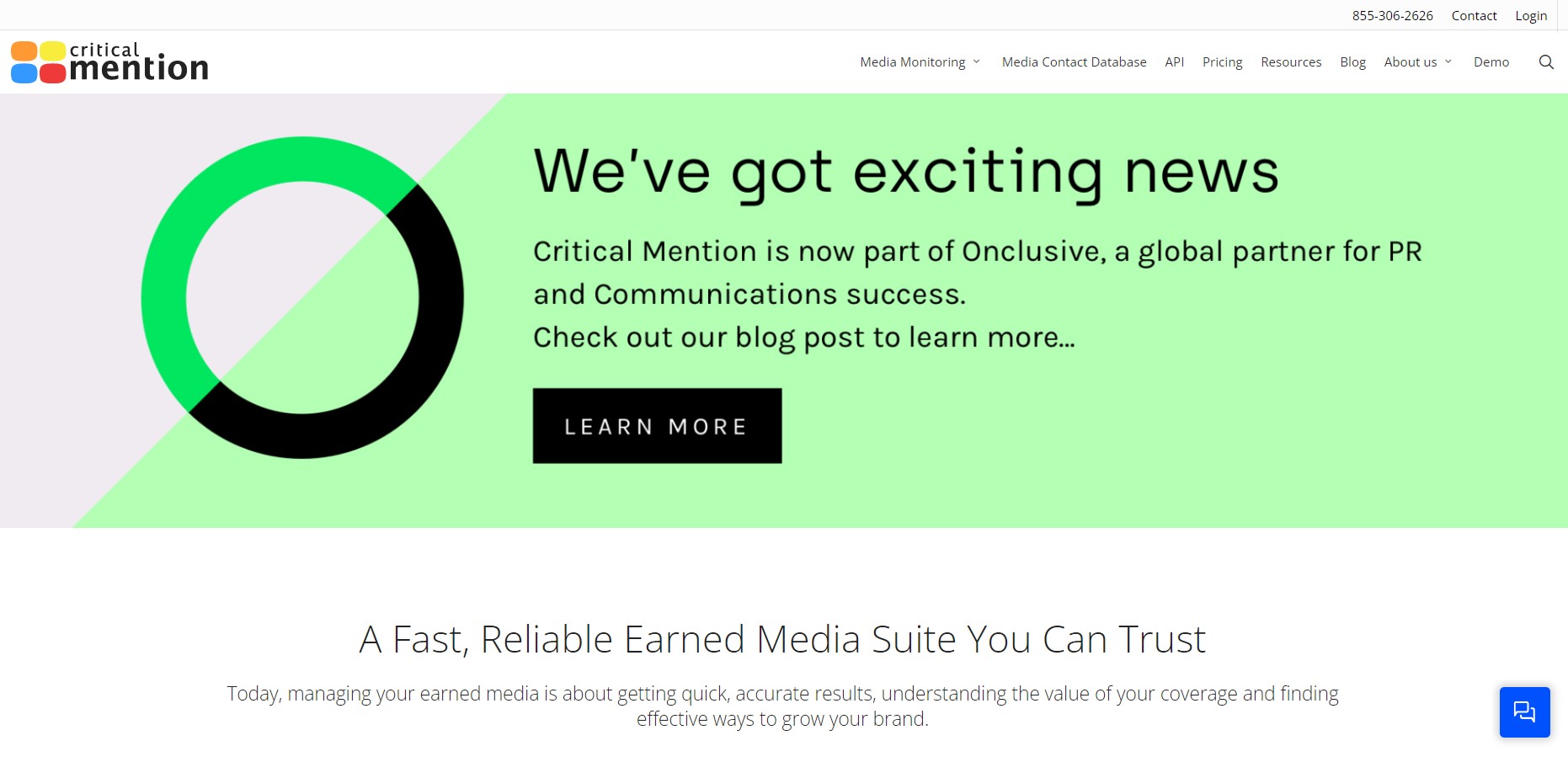
The company was founded in 2002 and is headquartered in New York, USA. It is a media intelligence platform that provides real-time broadcast, online, and social media monitoring.
What makes Critical Mention likeable?
Critical Mention does podcast monitoring and helps you stay on top of social media by monitoring platforms such as Twitter, Instagram, Facebook, and YouTube. However, they shine in their capability to perform traditional media monitoring. They can help track your brand mentions and earned media across over 2,500 TV and radio stations around the globe as per keywords search.
The search results are real-time, and you can use saved or ad-hoc searches to track specific keywords in the media that matter most to you. Additionally, you get access to international coverage in Europe and the Middle East. Also, Wordplay, their proprietary video editing tool, allows you to edit broadcast clips and highlight the text to get sentiment analysis for sections of them.
Critical Mention also helps you track your news coverage across global online publications, including online newspapers, magazines, blogs, and forums. You will receive instant alerts to enjoy a real-time view of your online media coverage. The news sources cover over 90 languages, including Chinese, French, German, Spanish, Portuguese, and Russian.
The Critical Mention API allows you to integrate with your existing system to access content, metadata, and historical archives. They have partners in industries from tech, finance, media, PR, and data journalism, to government. Consequently, this helps spot trends in big data.
Conclusion
Gaining an in-depth understanding of the ins and outs of your consumers’ feelings and thoughts is essential. This will help you improve your marketing campaigns, product innovation, consumer relations, and more.
In the past, humans did the sentiment analysis based on their own. However, given technological advancement, the sentiment analysis tools mentioned above will make the task easier and give you the valuable insights you need for your business success.
There isn’t one perfect sentiment analysis tool that can always give you 100% accuracy. That said, the tools listed above can still help you make more effective data-based decisions. In the end, they will give you more context about your consumers’ shifting sentiment, ultimately propelling your business forward.
Jason has spent over seven years as an Outreach Manager at WebRevenue.net. He loves building relationships with new people and that’s helped him form a strong network of companies, website owners, freelancers, and entrepreneurs. You can connect with him via LinkedIn.